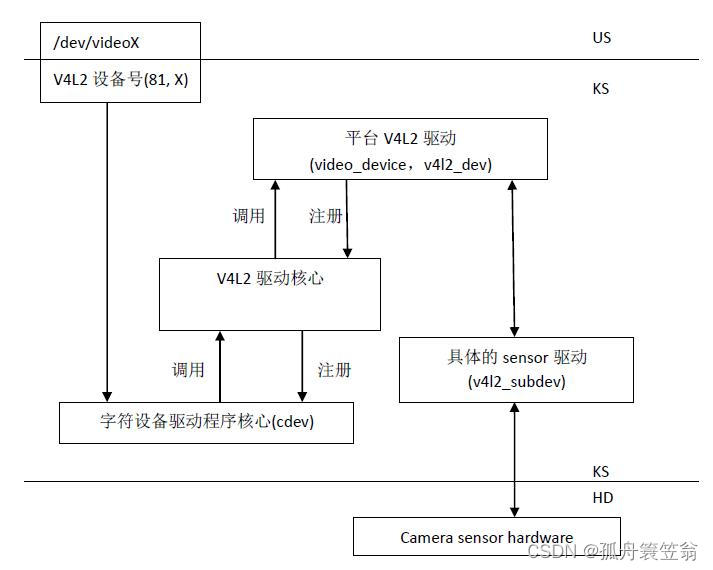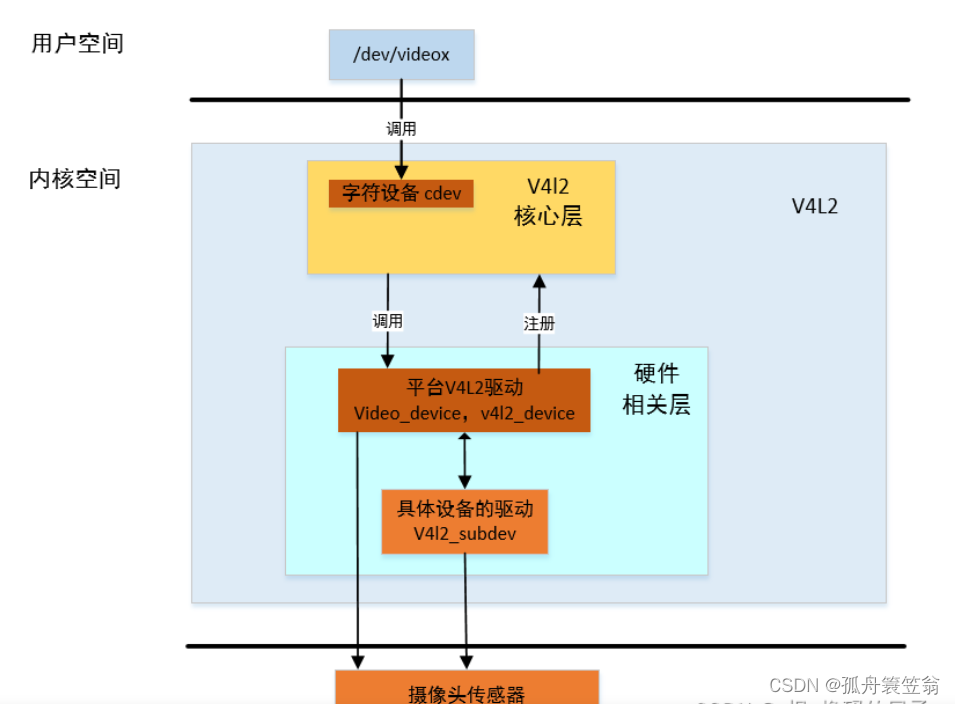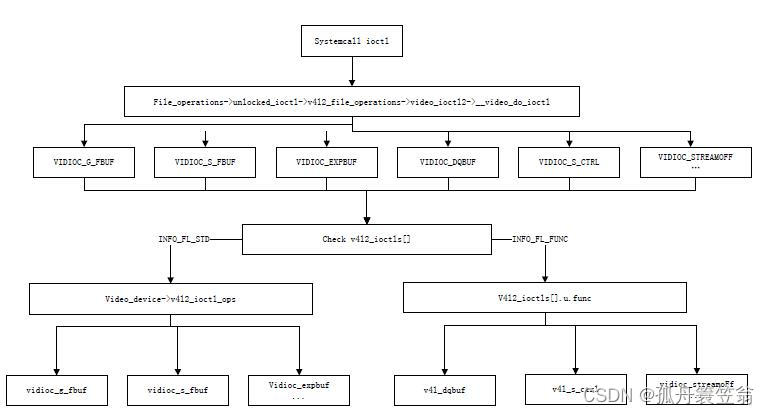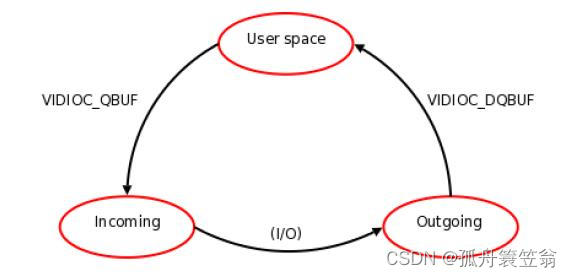一,概述
V4L2(Video for Linux 2)是Linux操作系统中用于支持摄像头和视频设备的框架。它提供了一组API和驱动程序接口,用于在Linux系统中进行视频采集、视频流处理和视频播放等操作。
V4L2的设计目标是支持多种设备,包括摄像头、视频采集卡等,并允许应用程序与这些设备通信。通过V4L2,可以实现图片、视频和音频的采集,这些功能在远程会议、可视电话、视频监控系统和嵌入式多媒体终端等场景中都有广泛的应用。
V4L2框架具有设备抽象层,这使得应用程序可以与各种不同类型的视频设备进行通信,而无需关心具体的硬件细节。此外,V4L2还提供了一系列回调函数,用于设置设备的参数,如摄像头的频率、帧频、视频压缩格式和图像参数等。
在编程方面,V4L2是针对uvc免驱USB设备的编程框架,主要用于采集USB摄像头等。在Linux编程中,一般使用ioctl函数来对设备的I/O通道进行管理,通过不同的命令标志符来执行各种操作,如分配内存、查询驱动功能、获取视频格式、设置频捕获格式等。
总的来说,V4L2是Linux系统中用于支持摄像头和视频设备的重要框架,为开发者提供了丰富的功能和灵活的编程接口。
V4L2支持三类设备:视频输入输出设备、VBI设备和radio设备(其实还支持更多类型的设备,暂不讨论),分别会在/dev目录下产生videoX、radioX和vbiX设备节点。我们常见的视频输入设备主要是摄像头,也是本文主要分析对象。下图V4L2在Linux系统中的结构图:
 二,V4L2框架
二,V4L2框架

Linux系统中视频输入设备主要包括以下四个部分:
字符设备驱动程序核心:V4L2本身就是一个字符设备,具有字符设备所有的特性,暴露接口给用户空间;
V4L2驱动核心:主要是构建一个内核中标准视频设备驱动的框架,为视频操作提供统一的接口函数;
平台V4L2设备驱动:在V4L2框架下,根据平台自身的特性实现与平台相关的V4L2驱动部分,包括注册video_device和v4l2_dev。
具体的sensor驱动:主要上电、提供工作时钟、视频图像裁剪、流IO开启等,实现各种设备控制方法供上层调用并注册v4l2_subdev。
V4L2的核心源码位于drivers/media/v4l2-core,源码以实现的功能可以划分为四类:
核心模块实现:由v4l2-dev.c实现,主要作用申请字符主设备号、注册class和提供video device注册注销等相关函数;
V4L2框架:由v4l2-device.c、v4l2-subdev.c、v4l2-fh.c、v4l2-ctrls.c等文件实现,构建V4L2框架;
Videobuf管理:由videobuf2-core.c、videobuf2-dma-contig.c、videobuf2-dma-sg.c、videobuf2-memops.c、videobuf2-vmalloc.c、v4l2-mem2mem.c等文件实现,完成videobuffer的分配、管理和注销。
Ioctl框架:由v4l2-ioctl.c文件实现,构建V4L2ioctl的框架。
video_device、v4l2_device和v4l2_subdev的关系:
 三,V4L2的数据结构
三,V4L2的数据结构
video_device
video_device结构体用于在/dev目录下生成设备节点文件,把操作设备的接口暴露给用户空间。
struct video_device
{/* character device */struct cdev *cdev;/* v4l2_device parent */struct v4l2_device *v4l2_dev;/* device ops */const struct v4l2_file_operations *fops;/* ioctl callbacks */const struct v4l2_ioctl_ops *ioctl_ops;
};
可以看到video_device中含有一个cdev还有v4l2_device,此外还有fops和ioctl_ops,从应用层进行系统调用会经过v4l2的核心层回调到这里
Video_device分配和释放,用于分配和释放video_device结构体:
struct video_device *video_device_alloc(void)void video_device_release(struct video_device *vdev)
video_device注册和注销,实现video_device结构体的相关成员后,就可以调用下面的接口进行注册:
static inline int __must_checkvideo_register_device(struct video_device *vdev,inttype, int nr)void video_unregister_device(struct video_device*vdev);
vdev:需要注册和注销的video_device;
type:设备类型,包括VFL_TYPE_GRABBER、VFL_TYPE_VBI、VFL_TYPE_RADIO和VFL_TYPE_SUBDEV。
ps: GRABBER在英文中的意思是掠夺者,video grabber 即 视频捕获器
nr:设备节点名编号,如/dev/video[nr]。
其中v4l2_file_operations和v4l2_ioctl_ops如下
struct v4l2_file_operations {struct module *owner;ssize_t (*read) (struct file *, char __user *, size_t, loff_t *);ssize_t (*write) (struct file *, const char __user *, size_t, loff_t *);unsigned int (*poll) (struct file *, struct poll_table_struct *);long (*ioctl) (struct file *, unsigned int, unsigned long);long (*unlocked_ioctl) (struct file *, unsigned int, unsigned long);unsigned long (*get_unmapped_area) (struct file *, unsigned long,unsigned long, unsigned long, unsigned long);int (*mmap) (struct file *, struct vm_area_struct *);int (*open) (struct file *);int (*release) (struct file *);
};
熟悉v4l2应用编程的应该都知道v4l2有很多ioctl操作,具体实现都在这里
struct v4l2_ioctl_ops {int (*vidioc_querycap)(struct file *file, void *fh, struct v4l2_capability *cap);/* Buffer handlers */int (*vidioc_reqbufs) (struct file *file, void *fh, struct v4l2_requestbuffers *b);int (*vidioc_querybuf)(struct file *file, void *fh, struct v4l2_buffer *b);int (*vidioc_qbuf) (struct file *file, void *fh, struct v4l2_buffer *b);int (*vidioc_dqbuf) (struct file *file, void *fh, struct v4l2_buffer *b);/* Stream on/off */int (*vidioc_streamon) (struct file *file, void *fh, enum v4l2_buf_type i);int (*vidioc_streamoff)(struct file *file, void *fh, enum v4l2_buf_type i);...
};
v4l2_device
struct v4l2_device {/* used to keep track of the registered subdevs */struct list_head subdevs;...
};
可以看到v4l2_device中有一个v4l2_subdev的链表,v4l2_device的主要目的时用来管理v4l2_subdev
可以看出v4l2_device的主要作用是管理注册在其下的子设备,方便系统查找引用到。
V4l2_device的注册和注销:
int v4l2_device_register(struct device*dev, struct v4l2_device *v4l2_dev)static void v4l2_device_release(struct kref *ref)
v4l2_subdev
struct v4l2_subdev {struct list_head list;struct v4l2_device *v4l2_dev;const struct v4l2_subdev_ops *ops;
};
v4l2_subdev中有一个v4l2_subdev_ops,实现了一系列的操作,供v4l2_device调用
struct v4l2_subdev_ops {const struct v4l2_subdev_core_ops *core;const struct v4l2_subdev_tuner_ops *tuner;const struct v4l2_subdev_audio_ops *audio;const struct v4l2_subdev_video_ops *video;const struct v4l2_subdev_vbi_ops *vbi;const struct v4l2_subdev_ir_ops *ir;const struct v4l2_subdev_sensor_ops *sensor;
};
struct v4l2_subdev_core_ops {...int (*s_config)(struct v4l2_subdev *sd, int irq, void *platform_data);int (*init)(struct v4l2_subdev *sd, u32 val);int (*s_gpio)(struct v4l2_subdev *sd, u32 val);int (*g_ctrl)(struct v4l2_subdev *sd, struct v4l2_control *ctrl);int (*s_ctrl)(struct v4l2_subdev *sd, struct v4l2_control *ctrl);int (*s_std)(struct v4l2_subdev *sd, v4l2_std_id norm);long (*ioctl)(struct v4l2_subdev *sd, unsigned int cmd, void *arg);...
};
struct v4l2_subdev_video_ops {...int (*enum_fmt)(struct v4l2_subdev *sd, struct v4l2_fmtdesc *fmtdesc);int (*g_fmt)(struct v4l2_subdev *sd, struct v4l2_format *fmt);int (*try_fmt)(struct v4l2_subdev *sd, struct v4l2_format *fmt);int (*s_fmt)(struct v4l2_subdev *sd, struct v4l2_format *fmt);int (*cropcap)(struct v4l2_subdev *sd, struct v4l2_cropcap *cc);int (*g_crop)(struct v4l2_subdev *sd, struct v4l2_crop *crop);int (*s_crop)(struct v4l2_subdev *sd, struct v4l2_crop *crop);int (*g_parm)(struct v4l2_subdev *sd, struct v4l2_streamparm *param);int (*s_parm)(struct v4l2_subdev *sd, struct v4l2_streamparm *param);...
};
Subdev的注册和注销
当我们把v4l2_subdev需要实现的成员都已经实现,就可以调用以下函数把子设备注册到V4L2核心层:
int v4l2_device_register_subdev(struct v4l2_device*v4l2_dev, struct v4l2_subdev *sd)
当卸载子设备时,可以调用以下函数进行注销:
void v4l2_device_unregister_subdev(struct v4l2_subdev*sd)
四,ioctl框架
你可能观察到用户空间对V4L2设备的操作基本都是ioctl来实现的,V4L2设备都有大量可操作的功能(配置寄存器),所以V4L2的ioctl也是十分庞大的。它是一个怎样的框架,是怎么实现的呢?
Ioctl框架是由v4l2_ioctl.c文件实现,文件中定义结构体数组v4l2_ioctls,可以看做是ioctl指令和回调函数的关系表。用户空间调用系统调用ioctl,传递下来ioctl指令,然后通过查找此关系表找到对应回调函数。
以下是截取数组的两项:
IOCTL_INFO_FNC(VIDIOC_QUERYBUF, v4l_querybuf,v4l_print_buffer, INFO_FL_QUEUE | INFO_FL_CLEAR(v4l2_buffer, length)),
IOCTL_INFO_STD(VIDIOC_G_FBUF, vidioc_g_fbuf,v4l_print_framebuffer, 0),
内核提供两个宏(IOCTL_INFO_FNC和IOCTL_INFO_STD)来初始化结构体,参数依次是ioctl指令、回调函数或者v4l2_ioctl_ops结构体成员、debug函数、flag。如果回调函数是v4l2_ioctl_ops结构体成员,则使用IOCTL_INFO_STD;如果回调函数是v4l2_ioctl.c自己实现的,则使用IOCTL_INFO_FNC。
IOCTL调用的流程图如下:

用户空间通过打开/dev/目录下的设备节点,获取到文件的file结构体,通过系统调用ioctl把cmd和arg传入到内核。通过一系列的调用后最终会调用到__video_do_ioctl函数,然后通过cmd检索v4l2_ioctls[],判断是INFO_FL_STD还是INFO_FL_FUNC。如果是INFO_FL_STD会直接调用到视频设备驱动中video_device->v4l2_ioctl_ops函数集。如果是INFO_FL_FUNC会先调用到v4l2自己实现的标准回调函数,然后根据arg再调用到video_device->v4l2_ioctl_ops或v4l2_fh->v4l2_ctrl_handler函数集。
五,IO访问
V4L2支持三种不同IO访问方式(内核中还支持了其它的访问方式,暂不讨论):
read和write,是基本帧IO访问方式,通过read读取每一帧数据,数据需要在内核和用户之间拷贝,这种方式访问速度可能会非常慢;
内存映射缓冲区(V4L2_MEMORY_MMAP),是在内核空间开辟缓冲区,应用通过mmap()系统调用映射到用户地址空间。这些缓冲区可以是大而连续DMA缓冲区、通过vmalloc()创建的虚拟缓冲区,或者直接在设备的IO内存中开辟的缓冲区(如果硬件支持);
用户空间缓冲区(V4L2_MEMORY_USERPTR),是用户空间的应用中开辟缓冲区,用户与内核空间之间交换缓冲区指针。很明显,在这种情况下是不需要mmap()调用的,但驱动为有效的支持用户空间缓冲区,其工作将也会更困难。
Read和write方式属于帧IO访问方式,每一帧都要通过IO操作,需要用户和内核之间数据拷贝,而后两种是流IO访问方式,不需要内存拷贝,访问速度比较快。内存映射缓冲区访问方式是比较常用的方式。
内存映射缓存区方式
硬件层的数据流传输
Camerasensor捕捉到图像数据通过并口或MIPI传输到CAMIF(camera interface),CAMIF可以对图像数据进行调整(翻转、裁剪和格式转换等)。然后DMA控制器设置DMA通道请求AHB将图像数据传到分配好的DMA缓冲区。
待图像数据传输到DMA缓冲区之后,mmap操作把缓冲区映射到用户空间,应用就可以直接访问缓冲区的数据。
vb2_queue
为了使设备支持流IO这种方式,驱动需要实现struct vb2_queue,来看下这个结构体:
struct vb2_queue {enumv4l2_buf_type type; //buffer类型unsignedint io_modes; //访问IO的方式:mmap、userptr etcconststruct vb2_ops *ops; //buffer队列操作函数集合conststruct vb2_mem_ops *mem_ops; //buffer memory操作集合structvb2_buffer *bufs[VIDEO_MAX_FRAME]; //代表每个bufferunsignedint num_buffers; //分配的buffer个数……};
Vb2_queue代表一个videobuffer队列,vb2_buffer是这个队列中的成员,vb2_mem_ops是缓冲内存的操作函数集,vb2_ops用来管理队列。
vb2_mem_ops
vb2_mem_ops包含了内存映射缓冲区、用户空间缓冲区的内存操作方法:
struct vb2_mem_ops {void *(*alloc)(void *alloc_ctx, unsignedlong size); //分配视频缓存void (*put)(void *buf_priv); //释放视频缓存//获取用户空间视频缓冲区指针void *(*get_userptr)(void *alloc_ctx,unsigned long vaddr, unsignedlong size, int write);void (*put_userptr)(void *buf_priv); //释放用户空间视频缓冲区指针//用于缓存同步void (*prepare)(void *buf_priv);void (*finish)(void *buf_priv);void *(*vaddr)(void *buf_priv);void *(*cookie)(void *buf_priv);unsignedint (*num_users)(void *buf_priv); //返回当期在用户空间的buffer数int (*mmap)(void *buf_priv, structvm_area_struct *vma); //把缓冲区映射到用户空间};
这是一个相当庞大的结构体,这么多的结构体需要实现还不得累死,幸运的是内核都已经帮我们实现了。提供了三种类型的视频缓存区操作方法:连续的DMA缓冲区、集散的DMA缓冲区以及vmalloc创建的缓冲区,分别由videobuf2-dma-contig.c、videobuf2-dma-sg.c和videobuf-vmalloc.c文件实现,可以根据实际情况来使用。
vb2_buffer是缓存队列的基本单位,内嵌在其中v4l2_buffer是核心成员。当开始流IO时,帧以v4l2_buffer的格式在应用和驱动之间传输。一个缓冲区可以有三种状态:
在驱动的传入队列中,驱动程序将会对此队列中的缓冲区进行处理,用户空间通过IOCTL:VIDIOC_QBUF把缓冲区放入到队列。对于一个视频捕获设备,传入队列中的缓冲区是空的,驱动会往其中填充数据;
在驱动的传出队列中,这些缓冲区已由驱动处理过,对于一个视频捕获设备,缓存区已经填充了视频数据,正等用户空间来认领;
用户空间状态的队列,已经通过IOCTL:VIDIOC_DQBUF传出到用户空间的缓冲区,此时缓冲区由用户空间拥有,驱动无法访问。
这三种状态的切换如下图所示:
 v4l2_buffer结构如下:
v4l2_buffer结构如下:
struct v4l2_buffer {__u32 index; //buffer 序号__u32 type; //buffer类型__u32 bytesused; 缓冲区已使用byte数__u32 flags;__u32 field;structtimeval timestamp; //时间戳,代表帧捕获的时间structv4l2_timecode timecode;__u32 sequence;/*memory location */__u32 memory; //表示缓冲区是内存映射缓冲区还是用户空间缓冲区union {__u32 offset; //内核缓冲区的位置unsignedlong userptr; //缓冲区的用户空间地址structv4l2_plane *planes;__s32 fd;} m;__u32 length; //缓冲区大小,单位byte};
当用户空间拿到v4l2_buffer,可以获取到缓冲区的相关信息。Byteused是图像数据所占的字节数,如果是V4L2_MEMORY_MMAP方式,m.offset是内核空间图像数据存放的开始地址,会传递给mmap函数作为一个偏移,通过mmap映射返回一个缓冲区指针p,p+byteused是图像数据在进程的虚拟地址空间所占区域;如果是用户指针缓冲区的方式,可以获取的图像数据开始地址的指针m.userptr,userptr是一个用户空间的指针,userptr+byteused便是所占的虚拟地址空间,应用可以直接访问。
六,源码剖析
V4L2驱动模板
此示例中并没有设计到v4l2_subdev,这部分将会在后面分析具体的驱动中出现
#include <...>static struct video_device* video_dev;
static struct v4l2_device v4l2_dev;/* 实现各种系统调用 */
static const struct v4l2_file_operations video_dev_fops = {.owner = THIS_MODULE,.release = vdev_close,.read = vdev_read,.poll = vdev_poll,.ioctl = video_ioctl2,.mmap = vdev_mmap,
};/* 实现各种系统调用 */
static const struct v4l2_ioctl_ops video_dev_ioctl_ops = {.vidioc_querycap = vidioc_querycap,.vidioc_enum_fmt_vid_cap = vidioc_enum_fmt_vid_cap,.vidioc_g_fmt_vid_cap = vidioc_g_fmt_vid_cap,.vidioc_try_fmt_vid_cap = vidioc_try_fmt_vid_cap,.vidioc_s_fmt_vid_cap = vidioc_s_fmt_vid_cap,.vidioc_reqbufs = vidioc_reqbufs,.vidioc_querybuf = vidioc_querybuf,.vidioc_qbuf = vidioc_qbuf,.vidioc_dqbuf = vidioc_dqbuf,.vidioc_enum_input = vidioc_enum_input,.vidioc_g_input = vidioc_g_input,.vidioc_s_input = vidioc_s_input,.vidioc_streamon = vidioc_streamon,.vidioc_streamoff = vidioc_streamoff,
};static int __init video_init(void)
{/* 分配并设置一个video_device */video_dev = video_device_alloc();video_dev->fops = &video_dev_fops;video_dev->ioctl_ops = &video_dev_ioctl_ops;video_dev->release = video_device_release;/* 注册一个v4l2_device */v4l2_device_register(video_dev->dev, &v4l2_dev); video_dev->v4l2_dev = &video_dev;/* 注册一个video_device字符设备 */video_register_device(video_dev, VFL_TYPE_GRABBER, -1);return 0;
}static void __exit video_exit(void)
{video_unregister_device(video_dev);v4l2_device_unregister(&v4l2_dev);video_device_release(video_dev);
}module_init(video_init);
module_exit(video_exit);如果你熟悉v4l2应用编程的话,你应该知道v4l2有许多ioctl操作,上面的模板就实现了很多ioctl操作
下面我们来分析分析源码
在上面的video_init中,我们分配并设置了video_dev,注册了v4l2_device(v4l2_device_register),然后向v4l2核心层注册video_device(video_register_device)
我们先来看v4l2_device_register
int v4l2_device_register(struct device *dev, struct v4l2_device *v4l2_dev)
{INIT_LIST_HEAD(&v4l2_dev->subdevs);spin_lock_init(&v4l2_dev->lock);dev_set_drvdata(dev, v4l2_dev);...
}
从源码中可以看出v4l2_device_register并没有做什么事,只是初始化链表,自旋锁,还有设置数据,这函数并不是我们的重点
下面来仔细分析video_register_device
int video_register_device(struct video_device *vdev, int type, int nr)
{ /* 分配字符设备 */vdev->cdev = cdev_alloc();/* 设置fops */vdev->cdev->ops = &v4l2_fops;/* 注册字符设备 */cdev_add(vdev->cdev, MKDEV(VIDEO_MAJOR, vdev->minor), 1);/* 生成设备节点 */dev_set_name(&vdev->dev, "%s%d", name_base, vdev->num);device_register(&vdev->dev);/* 设置全局数组 */video_device[vdev->minor] = vdev;
}
可以看到这个函数会为video_device分配一个cdev,然后设置fops,向内核注册字符设备,再者生成设备节点
然后设置video_device全局数组,video_device一个全局数组
static struct video_device *video_device[VIDEO_NUM_DEVICES];
保存着注册的video_device
另外,在sys/class/video4linux/下可以找到我们的设备节点。
我们注册的设备类型为VFL_TYPE_GRABBER,对应的节点名称video
第一个注册的设备从0开始,以此类推,因此节点名称为video0
用户可以打开dev/video0节点,通过IOCTL命令和内核空间进行通信。
接下来看一下其中设置的fops(v4l2_fops)
static const struct file_operations v4l2_fops = {.owner = THIS_MODULE,.read = v4l2_read,.write = v4l2_write,.open = v4l2_open,.get_unmapped_area = v4l2_get_unmapped_area,.mmap = v4l2_mmap,.ioctl = v4l2_ioctl,.release = v4l2_release,.poll = v4l2_poll,.llseek = no_llseek,
};
这个是video_device中的字符设备对应的fops,应用层发生系统调用会率先调用到这里,我们来好好看一看这些调用
v4l2_open
static int v4l2_open(struct inode *inode, struct file *filp)
{struct video_device *vdev;/* 根据次设备获得video_device */vdev = video_devdata(filp);/* 回调video_device的fops */if (vdev->fops->open)ret = vdev->fops->open(filp); //回调video
}
从这个函数可以看到,发生系统调用首先来到v4l2核心层的字符设备,然后再回调到对应的video_device,video_device在前面已经实现了v4l2_file_operations和v4l2_ioctl_ops一系列回调
v4l2_ioctl
V4L2的应用编程会有非常多的ioctl,会先调用到此处
static int v4l2_ioctl(struct inode *inode, struct file *filp,unsigned int cmd, unsigned long arg)
{struct video_device *vdev = video_devdata(filp);/* 回调到video_device中 */return vdev->fops->ioctl(filp, cmd, arg);
}
下面来看一看video_device怎么实现ioctl
static const struct v4l2_file_operations video_dev_fops = {.owner = THIS_MODULE,.release = vdev_close,.read = vdev_read,.poll = vdev_poll,.ioctl = video_ioctl2,.mmap = vdev_mmap,
};
从上面驱动程序的编写,我们可以知道video_device对应ioctl就是video_ioctl2,这个函数是内核提供的,我们看一看这个函数的内容
long video_ioctl2(struct file *file,unsigned int cmd, unsigned long arg)
{__video_do_ioctl(file, cmd, parg);
}
static long __video_do_ioctl(struct file *file,unsigned int cmd, void *arg)
{/* 获取video_device */struct video_device *vfd = video_devdata(file);/* 获取video_device的ioctl_ops */const struct v4l2_ioctl_ops *ops = vfd->ioctl_ops;switch (cmd) {case VIDIOC_QUERYCAP:ops->vidioc_querycap(file, fh, cap);case VIDIOC_ENUM_FMT:ops->vidioc_enum_fmt_vid_cap(file, fh, f);...}
}
可以看出,最终会调用到video_device实现的v4l2_ioctl_ops
/* 实现各种系统调用 */
static const struct v4l2_ioctl_ops video_dev_ioctl_ops = {.vidioc_querycap = vidioc_querycap,.vidioc_enum_fmt_vid_cap = vidioc_enum_fmt_vid_cap,.vidioc_g_fmt_vid_cap = vidioc_g_fmt_vid_cap,.vidioc_try_fmt_vid_cap = vidioc_try_fmt_vid_cap,.vidioc_s_fmt_vid_cap = vidioc_s_fmt_vid_cap,.vidioc_reqbufs = vidioc_reqbufs,.vidioc_querybuf = vidioc_querybuf,.vidioc_qbuf = vidioc_qbuf,.vidioc_dqbuf = vidioc_dqbuf,.vidioc_enum_input = vidioc_enum_input,.vidioc_g_input = vidioc_g_input,.vidioc_s_input = vidioc_s_input,.vidioc_streamon = vidioc_streamon,.vidioc_streamoff = vidioc_streamoff,
};
所以系统调用最先都会调用到字符设备的fops,然后经过v4l2核心层最终调用到video_device这里
关于v4l2的驱动框架就分析到这里,关于更加详细的实现v4l2驱动,将在后续文章中通过实例讲解






 月报 (AIRSIL3MSOLR))


 | 如何高效切割合并内存块)

)

—— 广度优先)





